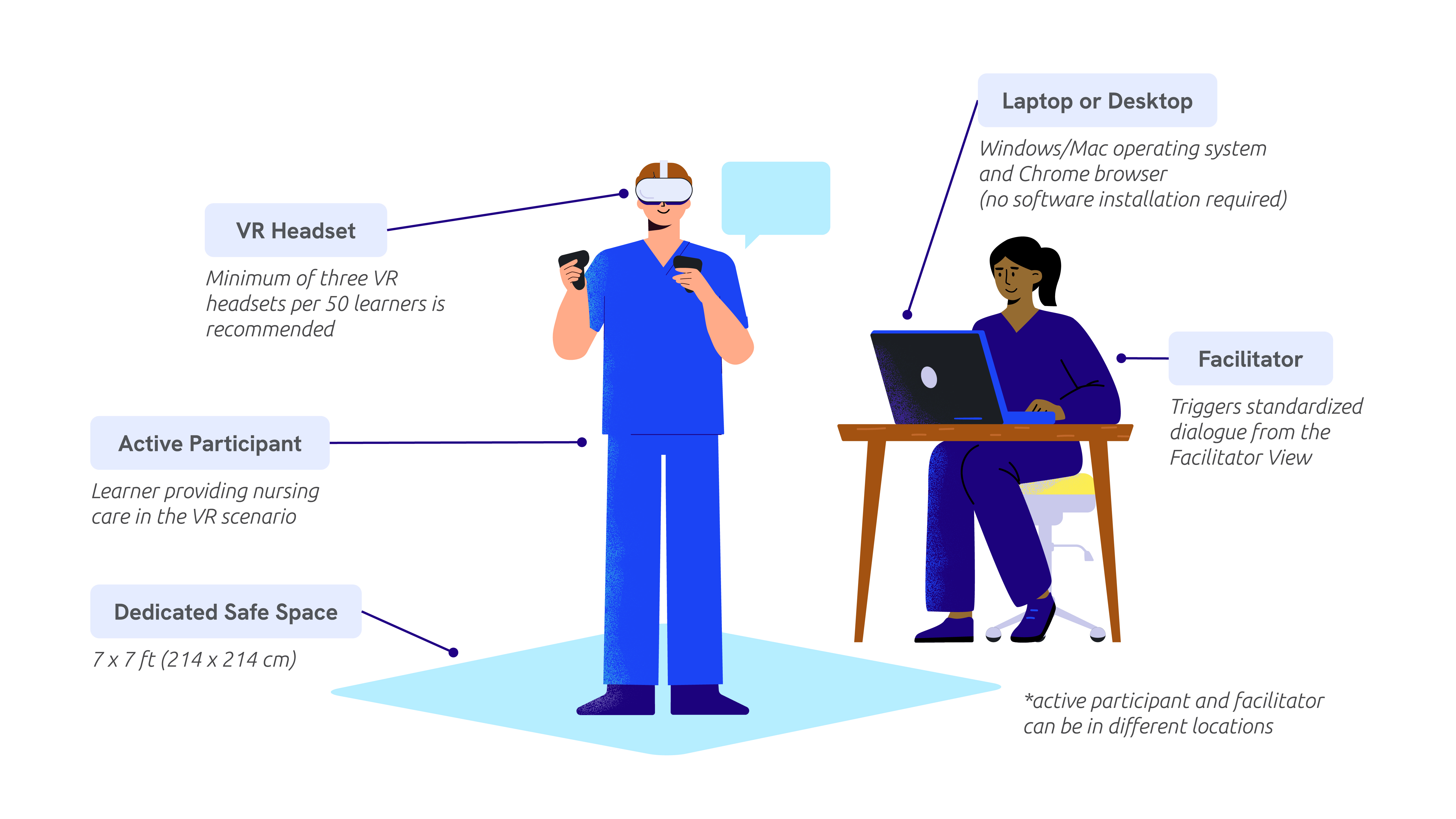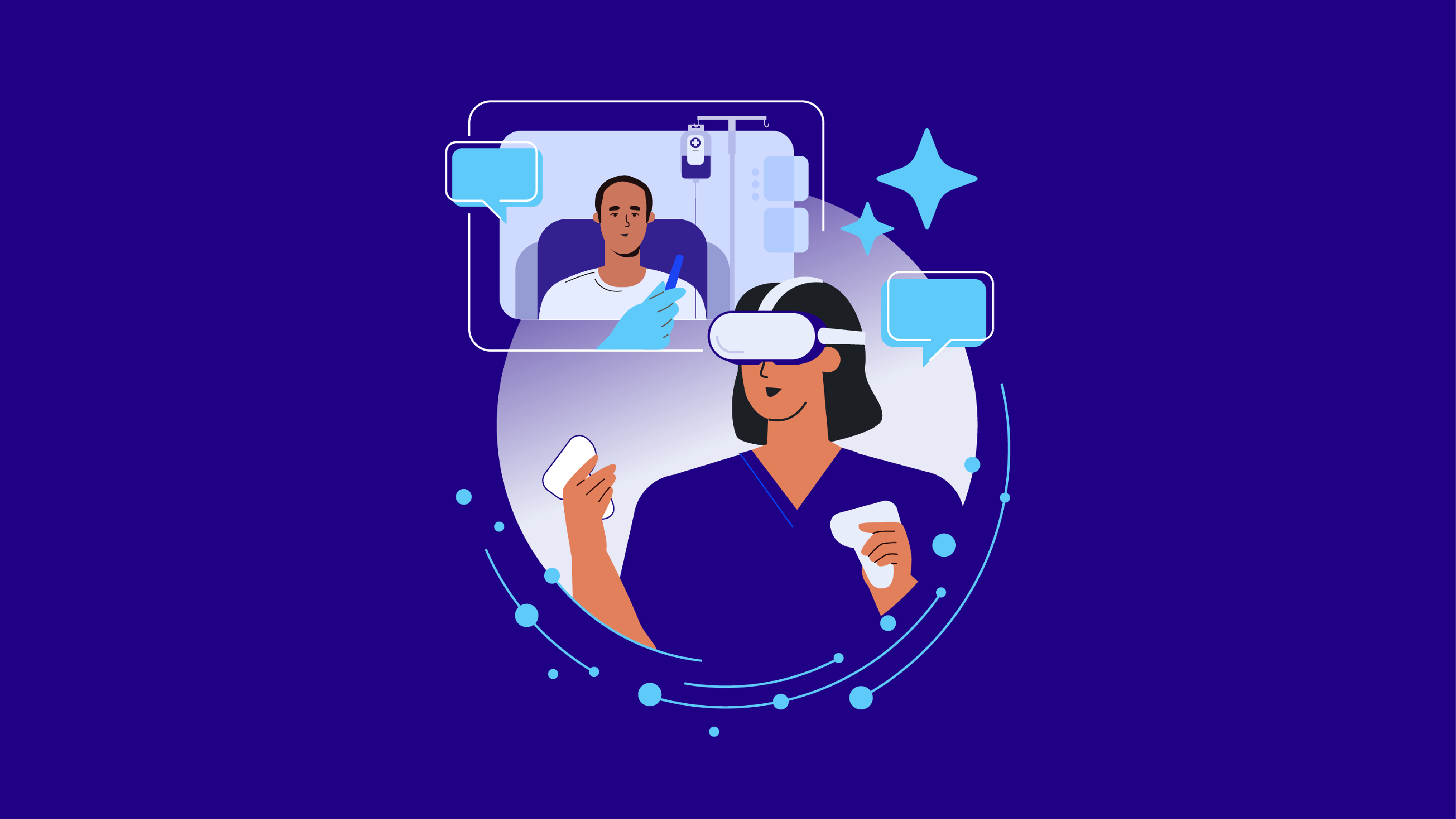What Equipment Do Nursing Programs Need to Get Started With VR Simulation?

Table of Contents
Name of the heading
1- Start your table with the syntax {start-table}
2 - Add an H3 Heading to create a new column (this will be the column title)
3 - List cells as bullet points in a List element
4 - End your table with the syntax {end-table}
Nursing simulation labs now go beyond just manikins. Many programs are turning to virtual reality (VR) for immersive training and education. But if you’re building a VR simulation lab, one of the first questions is: What equipment do we really need to get started?
Here’s the essential VR simulation equipment nursing programs need to get started:
- A Meta Quest headset (Quest 3 or Quest 3s recommended)
- Hand controllers (included with headsets)
- Sanitation and charging tools (alcohol wipes, carts, docking stations)
- VR training software like UbiSim
- Laptop or desktop
- A reliable Wi-Fi connection
- A safe, open space (7x7 feet per user)

With these basics, programs can start running VR simulations right away. This guide dives deeper into each category, whether you’re on a tight budget or planning a fully equipped lab.
What VR headsets and controllers work best for nursing simulation?
Choosing the right headset is one of the most important steps in your simulation lab VR setup. VR headsets provide flexibility and are easy to deploy without high-end computers.
- Meta Quest 3 Headset: High-performance headset with excellent graphics and mixed reality features.
- Meta Quest 3s Headset: Budget-friendly alternative with slightly fewer features, ideal for cost-conscious programs.
- Meta Quest 2 Headset: Older but still usable model (discontinued by Meta, so harder to source).
- Hand Controllers: Standard with Meta headsets, providing haptic feedback for realistic skill practice.
Which VR software and apps are essential for nursing education?
The right VR software for nursing education turns the hardware into a powerful training tool. Key solutions include:
- Device Management Software (ex: ArborXR): Deploys apps, monitors usage, and pushes updates across headsets.
- Casting & File Transfer (Meta Quest Link): Shares VR sessions on a display or transfers files between headsets and computers.
- VR Nursing Simulation Software (ex: UbiSim): Provides realistic nursing scenarios for immersive practice.
How can nursing programs organize, charge, and sanitize VR hardware?
Keeping VR equipment clean, charged, and ready is critical for faculty and students. Common solutions include:
- LED Sanitation Stations: Quick, effective disinfection to reduce germ spread.
- Alcohol Wipes: Simple, portable cleaning solution.
- Charging Carts: Store and charge multiple headsets at once.
- Docking Stations: Compact storage/charging for smaller setups.
- Power Strips & Extension Cords: Ensure access to all devices.
- AA Batteries: Required for Quest hand controllers.
- Color-Coding Systems: Label equipment for easy identification.
What internet connectivity is required for VR simulation?
Reliable internet is part of the minimum tech requirements for VR simulation. Ensure that any laptop or desktop used in your VR setup has a stable internet connection for smooth device management and multi-user sessions.
- Wi-Fi Router: A dedicated, high-speed router (at least 10 Mbps) ensures smooth VR experiences.
- Stable Connection: Especially important for multi-user sessions or device management.
Do nursing programs need dedicated VR spaces?
While VR can be used in flexible classrooms, dedicated spaces improve safety and immersion:
- Space Requirements: Allocate at least 7x7 feet per student.
- Projection or Display Screen: Let instructors and peers observe sessions in real-time.
- Speakers: Enhance audio for observers.
- Mats or Cushioned Flooring: Increase comfort and safety for longer sessions.
What else should nursing programs consider when starting with VR simulation?
Beyond hardware, software, and space, a few additional considerations can help ensure a smooth rollout and long-term success:
- Curriculum alignment: Plan how VR fits into learning objectives and course outcomes so it supplements existing simulation activities.
- Assessment and tracking: Leverage VR performance data for student feedback, competency assessment, or identifying areas needing extra practice.
- IT and network support: Ensure sufficient bandwidth, firewall configurations, and IT support to prevent technical disruptions during VR sessions.
- Pilot and scale strategy: Start small with a few headsets and scenarios to refine workflows before expanding to a full lab to see if your VR provider works.
Final Thoughts
Getting started with VR simulation doesn’t mean overhauling your entire lab. With the right VR hardware, software, and space setup, nursing programs can offer immersive training that builds clinical confidence and bridges the gap between classroom learning and practice.
FAQs
Heading 1
Heading 2
Heading 3
Heading 4
Heading 5
Heading 6
Lorem ipsum dolor sit amet, consectetur adipiscing elit, sed do eiusmod tempor incididunt ut labore et dolore magna aliqua. Ut enim ad minim veniam, quis nostrud exercitation ullamco laboris nisi ut aliquip ex ea commodo consequat. Duis aute irure dolor in reprehenderit in voluptate velit esse cillum dolore eu fugiat nulla pariatur.
Block quote
Ordered list
- Item 1
- Item 2
- Item 3
Unordered list
- Item A
- Item B
- Item C
Bold text
Emphasis
Superscript
Subscript
Explore more

From 30 Minutes to 3: How AI Enhanced Analytics Transforms Debriefing Preparation
AI Enhanced Analytics: Scenario Performance Data now available in UbiSim's Version 1.19
.jpg)
Behind the Scenes: How We Brought Incisions & Dressings to Life in VR
How the UbiSim team built a VR system displaying 300+ distinct incision states—balancing clinical accuracy, technical constraints, and nursing education needs.
.jpg)
Step Inside the Room of Errors: Playful Exploration, Serious Skills
Learn how UbiSim's Room of Errors transforms nurse training through investigative play. Students spot hidden safety risks and build situational awareness.




